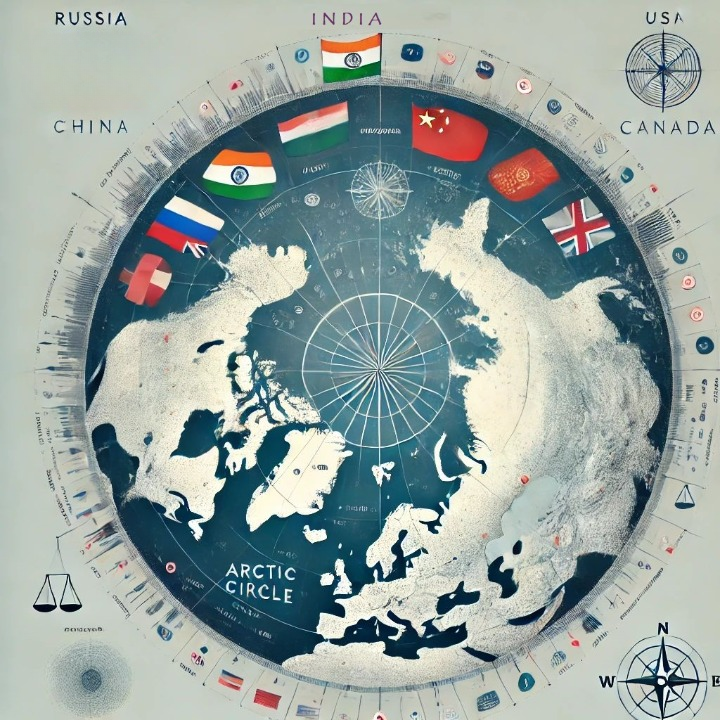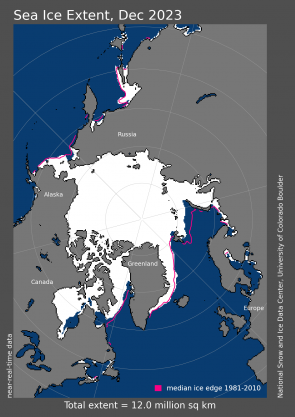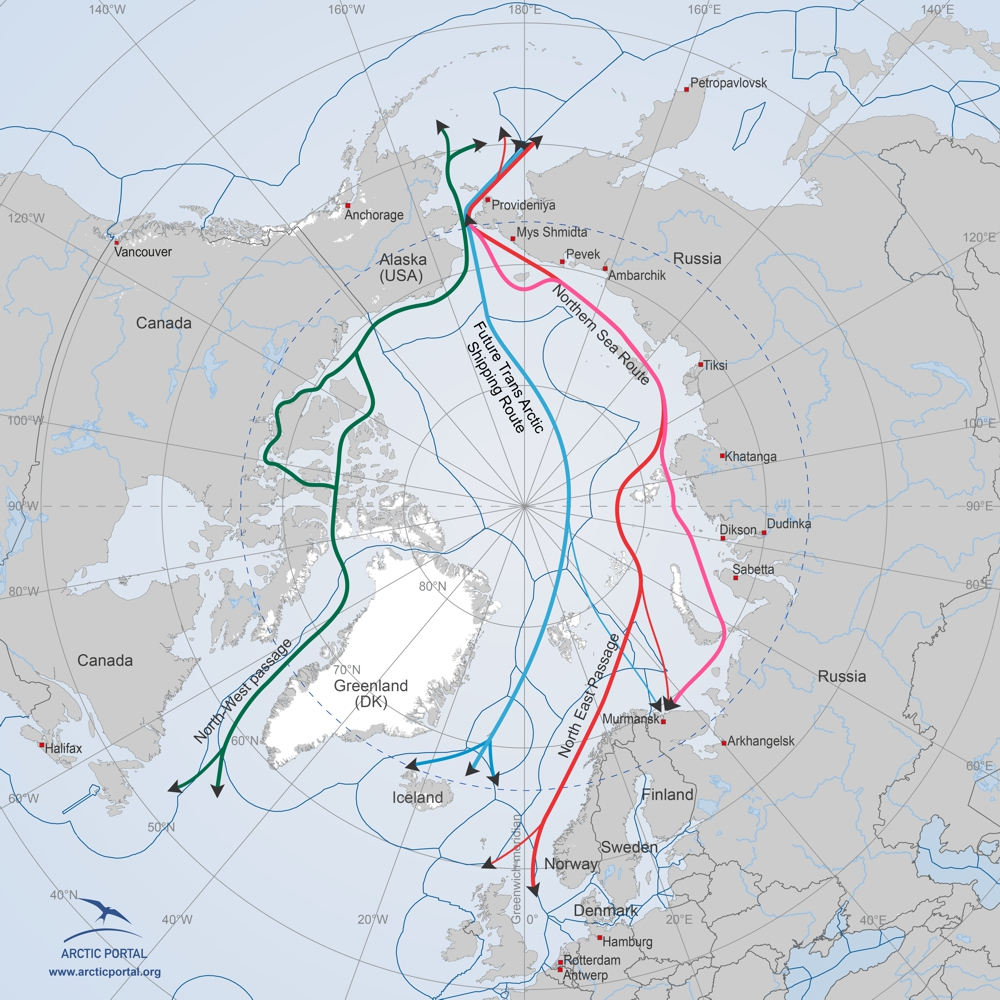
- The Arctic region also holds a vast amount of untapped resources that range from reserves of oil, natural gas and minerals, which makes it an area for exploration for emerging economies like India and China for their energy security needs.
- China has based its Arctic Policy on four goals: to understand, protect, develop and participate in the governance of the Arctic, and four basic principles that become the foundation for its course of action in the Arctic Region.
- India’s Arctic Policy emphasises not only from an environmental perspective but also from the perspective of building cooperation, exploration of resources, and respect for international law under UNCLOS.
- The idea of high north and low tension seems to be gradually witnessing changes that would alter the status quo as the competition in this region among major states with divergent national interests comes into play.
The rapidly changing geopolitics and the increasing demand for resources have led to a significant increase in the importance of the Arctic region. Pressing issues like climate change, the rapid melting of ice, and the geoeconomic and geo-strategic influence of the Arctic capture the major debates discussed in this region. According to the latest report by the National Snow and Ice Data Center, the Arctic, “Average Arctic sea ice extent for December 2023 was 12.00 million square kilometres (4.63 million square miles), ninth lowest in the 45-year satellite record. Sea ice extent increased by an average of 87,400 square kilometres (33,700 thousand square miles) per day, markedly faster than the 1981 to 2010 average of 64,100 square kilometres (24,700 square miles) per day.” [1]
This change in the geography of the Arctic is gradually finding clear and objective repercussions on the geopolitical and geostrategic contours of this region. The much-celebrated Norwegian spirit of “High North, Low Tension” [2] that aims for a ‘softer’ form of cooperation in the Arctic seems to have gradually dwindled due to the geopolitical shift in this region.
In this context, this paper attempts to analyse the Arctic and its changing dynamics from five vantage points. They are a) Why the Arctic?, b) Stakes of Russia, c) Concerns for the US, d) Eye of China and lastly e) Significance for India.

Why does the Arctic matter?
The Arctic is fundamental to the functioning of the Earth as an organic unit and is often considered Earth’s polar cap. Covering almost four per cent of the earth’s surface, the Arctic holds importance not only from scientific and environmental perspectives but also from geopolitical, economic and strategic perspectives.
The Arctic has remained a prominent hub for scientific study, where many countries have come forward to do their research work to decipher the ongoing changes and the future potential impact of such changes that may turn severe and also provide new areas of economic exploration. Climate change is a major factor that has affected this region. According to a recent report, it is estimated that by 2030, the world is likely to witness an ice-free Arctic. This projection is approximately a decade before the recent projection by the IPCC. [3]
This region also holds a vast amount of untapped resources that range from reserves of oil, natural gas and minerals, which makes it an area for exploration for emerging economies like India and China for their energy security needs. According to a report by the U.S. Energy Information Administration, “The Arctic holds an estimated 13% (90 billion barrels) of the world’s undiscovered conventional oil resources and 30% of its undiscovered conventional natural gas resources”. [4]
The geopolitical importance of the Arctic has gained more prominence in the recent past. Major states like the U.S., Russia, China and India have come up with their policy document on the Arctic. The Arctic Council has turned out to be a major organisation in the governance of this region, but the cooperation under the council has turned out to be an uphill task.
Stakes of Russia
The evolving geopolitics of the high north has made the Arctic of critical importance for Russia. Holding multidimensional interests in this region, Russia’s former deputy Prime Minister Dmitry Rogozin claimed that, “The Arctic is a Russian Mecca”.[5] This statement portrays the centrality of the Arctic in determining and defining the geopolitical interest of Russia in this region.
Over time, Russia has come up with policy documents on the Arctic beginning in 2004, 2008, and 2020 and made the latest amendment in February 2023. The policy document is called ‘Basic Principles of the Russian Federation State Policy in the Arctic to 2035’.[6]
However, in this regard, a significant mark of observation came to the forefront when it was noticed that the document originally published in March 2020 made room for cooperation with the Arctic states under the pretext of multilateral regional cooperation formats to foster economic, scientific, technological and cultural cooperation. But this went for a striking change when the policy document was amended in February 2023. The amended policy placed the focus on prioritising ‘national interest’, monitoring the safety of navigation, and developing relations more bilaterally.[7]
From an economic perspective, the Arctic holds great importance for Russia. The Russian economic investment in the Arctic could exceed $86 bln by 2025 and is likely to reach $210 bln by 2050.[8] At present, 20% of the country’s GDP and 30% of its exports come from this region.[9] The Arctic, relatively, has not been much explored compared to other regions of the planet. Therefore, it has turned out to be an area for the upcoming exploration of oil and gas. Broadly, 80% of the gas and 60% of the oil produced in Russia are extracted from the Arctic.[10] Therefore, the Arctic is fundamental to the energy security of Russia.
The concern of the U.S.
In October 2022, the United States came up with its policy for the Arctic, named “National Strategy for the Arctic Region”, which presents a holistic view of the US approach to the Arctic. Based on four fundamental pillars of Security, climate change and environmental Protection, Sustainable Economic Development and International Cooperation and Governance, this policy document sets the road for the U.S. from 2022-2032. The document highlights the geopolitical concerns of this region, where the US raises the concern that it considers to have come from Russia. It states that “strategic competition in the Arctic since 2013, exacerbated by Russia’s unprovoked war in Ukraine, seeks to position the United States to both effectively compete and manage tensions”.[11]
The U.S. has also raised concerns about the rising influence of the non-Arctic states in this region, which addresses the presence of China as a major power in this region. The increasing role of China in shaping the regional governance of the Arctic, scientific exploration, and China’s icebreaker fleets has led the U.S. to keep a close watch on China. The policy document highlights the potential military implications of the Arctic, where it states that scientific exploration can be used to “conduct dual-use research with intelligence or military applications in the Arctic”.[12]
China, in this regard, taking an edge over the US has started building a third icebreaker which holds the potential to take researchers to the polar seabeds by 2025.
The development in technology for shipbuilding can be a game changer in the context of exploring the Arctic. However, in this regard, development on the part of the US has turned out to be significantly lower when compared with China. In a recent report by the United States Government Accountability Office (GAO), it was highlighted that the Polar Security Cutter needs to further enhance and stabilise its design. The report stated that “The Polar Security Cutter’s (PSC) design is not yet mature, which has led to an extended design phase and contributed to a 3-year schedule delay in the shipyard, with the construction of the first cutter now planned for March 2024. Coast Guard officials attribute the extended design phase to various challenges. For example, icebreaking hulls require thick steel, up to twice as thick as a non-icebreaker and a dense framing structure that has been challenging to plan for the PSC. Additionally, Coast Guard officials stated that U.S.-based shipbuilders have limited expertise in designing and building heavy polar icebreakers.”[13]
On a comparative note, China, in this regard, taking an edge over the US has started building a third icebreaker which holds the potential to take researchers to the polar seabeds by 2025.[14] This has proved to be a major geopolitical edge in the exploration of the Arctic.
The Eyes of China
In January 2018, China came up with its White Paper on the Arctic region named “China Arctic Policy”. This policy document covers the broad contours of how China perceives the Arctic region and what its goals and objectives are that it would strive to achieve in the due course of time. China claims itself as a “Near Arctic State” in its white paper and considers itself “an important stakeholder in the Arctic affairs”.[15]
China has based its Arctic Policy on four goals and four basic principles that become the foundation for its course of action in the Arctic Region. The goals that China have for the Arctic are: to understand, protect, develop and participate in the governance of the Arctic. The basic principles on which it has based its policy are respect, cooperation, win-win results and sustainability.[16]
Keeping these principles in perspective, connectivity projects have often been a major initiative taken by China at an international level, the 21st-century Maritime Silk Road being a prominent one. It is on these lines that China has come up with its ambitious project jointly to build a “Polar Silk Road’ for better connectivity, and economic and social development of the Arctic region.
Map of the Polar Silk Route

This sea route comprises three major routes. The Northwest Passage passes through Canada and the United States. The Northeast Passage transits through the Russian Arctic and flows into Europe. The central passage also holds great significance as it moves through the heart of the Arctic, crossing very closely through the North Pole, which could help drop fuel consumption by almost 40 per cent.[17]
Energy security for China is a crucial issue, and the untapped resources-rich region of the Arctic has provided an area where China is keen to explore new possibilities to fulfil its energy demand. According to the latest data, it is estimated that China, from 2005-2017, has invested over $1.4 trillion in the economies of the Arctic nations (including Finland and Sweden). It is also estimated that the Arctic economy is approximately $450 billion, and the investment by the Chinese holds a major part of the Chinese capital.[18]
Significance for India
India’s connection with the Arctic can be traced historically to the works of Tilak. His work argues that the original homeland of the Aryans lies in the Arctic [19]. It also discusses the polar attributes of the Vedic deities and emphasises the cultural-historical geography of this region and its connection with India.[20] However, officially, it was in February 1920 that India, under British rule, signed the Svalbard Treaty.[21] India initiated its Arctic Research Program in the year 2007 when the Indian Arctic Research team studied the relationship between the Arctic climate with the Indian monsoon. In 2008, India also opened its Arctic research base named Himadri at Ny-Alesund, Svalbard and Norway. India was also elected to the Council of the International Arctic Science Committee (IASC) in 2012 and was later granted observer status to the Arctic Council on May 1, 2013. Later in May 2019, India was re-elected to the Arctic Council.[22]
In March 2022, India came up with its first Arctic policy named ‘India’s Arctic Policy – Building a Partnership for Sustainable Development’.[23] This policy emphasises the critical importance of the Arctic for India, not only from an environmental perspective but also from the perspective of building cooperation, exploration of resources, and respect for international law under UNCLOS.
The policy, in this regard, is built on six fundamental pillars that provide a robust and holistic approach to work in the Arctic. These six pillars include a) Science and Research, b) Climate and Environmental Protection, c) Economic and Human Development, d) Transportation and Connectivity, e) Governance and International Cooperation, and e) National Capacity Building. This largely provides a holistic approach to India for the Arctic region.
By 2047, India and Russia will partner for the development of the North Sea Route and the full operationalisation of the International North-South Transport Corridor.
Following its endeavour of scientific research, on December 18, 2023, India launched its first maiden ‘Winter Scientific Expedition’ to the Arctic from the Ministry of Earth Science (MoES). Since 2008, India has conducted the research mostly during the summer (April to October). However, this winter research expedition (November to March) will help the researchers conduct their scientific observation, especially during polar nights. During this time, there is no availability of sunlight for nearly 24 hours, and the temperature remains sub-zero and can go to as low as -15 degrees Celsius.[24] This scientific expedition is facilitated under the PACER (Polar and Cryosphere) scheme through the National Centre for Polar and Ocean Research (NCPOR), Goa, an autonomous institute of the MoES. The monsoon of India and its close connection with the Arctic region is also a significant domain of research for India, which is heavily dependent on agriculture.
Exploring alternate shipping maritime routes with friendly states stands fundamental to India’s foreign initiatives that hold a direct implication for India’s economic and strategic interests. This is reflected in the recent development of the Chennai Vladivostok Eastern Maritime Corridor, exploring the North Sea Route, often known as the Arctic Route. Signed in September 2019 by Prime Minister Narendra Modi, the corridor spans across 6000 km linking the Indian Ocean and the Pacific Ocean, connecting the port city of Chennai to the port city of Vladivostok in the Far East Region. The corridor holds the potential to provide a boost to bilateral trade and investment, cooperation in the energy sector, and growth in transport and tourism. This route is directly linked to addressing the issue of India’s energy security, which would provide resources for India from the resource-rich Far East of Russia to a resource-deficient and energy-dependent Indian market that imports 87% of its oil and 65% of its gas.[25]
A recent development, in this regard, was a workshop organised by Chennai Port Authority named as the “India-Russia Workshop On Operationalisation of the Eastern Maritime Corridor”. The workshop witnessed the participation of Shri Sarbananda Sonowal, Hon’ble Union Minister for Ports, Shipping and Waterways. He highlighted the importance of development towards India’s ambitious idea of a Blue Economy. By 2047, India and Russia will partner for the development of the North Sea Route and the full operationalisation of the International North-South Transport Corridor. He also emphasised the idea of making ‘Indian Seafarers competent and trained to navigate the Arctic by training collaborations with Russia and promoting icebreaker shipbuilding at Indian Shipyards’.[26]
Easternization of the Arctic: The Arctic, historically, has remained an area of influence by countries like the U.S., Canada, Russia and other Nordic countries. However, due to the evolving world order, this dynamic has witnessed a significant change. The increasing engagement of Asian states, especially China and India, in this regard has shifted the dynamics of geopolitical influence. The increase in investments in infrastructure, shipping routes, freedom of navigation, and the overall governance of the Arctic under the Arctic Council has turned out to be a major initiative for all the stakeholders. In this regard, Russia, with the goal of regional development, has increased cooperation with India and China, whose interests are taken into consideration as the region gains more prominence.[27] This change in the engagement is gradually perceived as the Easternisation of the Arctic.
Conclusion
The Arctic, due to its unique position, is gaining significant geopolitical importance. It stands fundamental in the strategic calculation of the major powers, the U.S., Russia and China in particular. The vast amount of resources, its impact on climate change, the need for scientific exploration and its centrality to international affairs make the Arctic a region of critical importance.
Due to ice melting, the region is gradually becoming more accessible for navigation. The ambitious Polar Silk Route by China sufficiently describes the geoeconomic importance of the Arctic. The sanction imposed by the EU on Russia diverted the Arctic oil export to Asia via the Northern Sea Route, where India and China turned out to be the recipients of this oil.[28] The governance of the Arctic is also an area of focus that provides all stakeholders with a fair playing ground for sustainable use of the resources. This includes freedom of navigation, abiding by international law, and following the UNCLOS.
A summation of the above analysis states the critical importance of the Arctic. This region is likely to turn into an area where the spotlight of geopolitics will be focused on for keen observations and analysis. The much-celebrated idea of high north and low tension from the above analysis seems to be gradually witnessing changes that would alter the status quo as the competition in this region among major states with divergent national interests comes into play.
References:
- [1] Arctic Sea Ice News and Analysis | Sea ice data updated daily with one-day lag. (2024, January 4). National Snow and Ice Data Center. Retrieved January 8, 2024, from https://nsidc.org/arcticseaicenews/
- [2] Østhagen, A. (2021, April 25). Norway’s Arctic policy: still high North, low tension? The Polar Journal, 11, 75-94. https://doi.org/10.1080/2154896X.2021.1911043
- [3] Ice free Arctic likely to become a reality as early as 2030. (2023, July 30). Bonpote. Retrieved February 05, 2024, from https://bonpote.com/en/ice-free-arctic-likely-to-become-a-reality-as-early-as-2030/#:~:text=After%20decades%20of%20sounding%20the,co%2Dauthor%20of%20the%20article.
- [4] Circum-Arctic Resource Appraisal: Estimates of Undiscovered Oil and Gas North of the Arctic Circle. (n.d.). Retrieved February 5, 2024, from https://pubs.usgs.gov/fs/2008/3049/fs2008-3049.pdf
- [5] Tharoor, I. (2015, April 20). The Arctic is Russia’s mecca, says top Moscow official. Anchorage Daily News. Retrieved January 11, 2024, from https://www.adn.com/nation-world/article/arctic-russias-mecca-says-top-moscow-official/2015/04/21/
- [6] Указ Президента Российской Федерации от 05.03.2020 г. № 164. (2020, March 5). Президент России. Retrieved January 11, 2024, from http://www.kremlin.ru/acts/bank/45255/page/2
- [7] Arroyo, M. (2021, September 22). Changes were made to the Fundamentals of Public Policy in the Arctic for the Period Until 2035. Retrieved January 11, 2024, from http://kremlin.ru/acts/news/70570?utm_referrer=korabel.ru%2Fnews%2Fcomments%2Fvneseny_izmeneniya_v_osnovy_gosudarstvennoy_politiki_v_arktike.html
- [8] Investments in Russian economy in Arctic to exceed $86 bln until 2025. (2019, March 29). TASS. Retrieved January 15, 2024, from https://tass.com/economy/1051080
- [9] Premack, R. (2023, January 19). Russia’s Arctic shipping, drilling key for its future. FreightWaves. Retrieved January 15, 2024, from https://www.freightwaves.com/news/stronghow-russia-is-leveraging-its-arctic-region-for-global-influencestrong
- [10] Tracy, E. F. (2023, November 30). For the good of the whole planet, stop fossil fuel production in the Arctic. WWF Arctic. Retrieved January 15, 2024, from https://www.arcticwwf.org/newsroom/features/for-the-good-of-the-whole-planet-stop-fossil-fuel-production-in-the-arctic/
- [11] NATIONAL STRATEGY FOR THE ARCTIC REGION. (2022, October). The White House. Retrieved February 12, 2024, from https://www.whitehouse.gov/wp-content/uploads/2022/10/National-Strategy-for-the-Arctic-Region.pdf
- [12] Ibid.
- [13] United States Government Accountability Office. (2023, July 27). GAO-23-105949, COAST GUARD ACQUISITIONS: Polar Security Cutter Needs to Stabilize Design Before Starting Construction and Improv. Government Accountability Office. Retrieved February 14, 2024, from https://www.gao.gov/assets/gao-23-105949.pdf
- [14] Xie, E. (2023, June 27). China starts building icebreaker that could send experts to polar seabed by 2025. South China Morning Post. Retrieved February 14, 2024, from https://www.scmp.com/news/china/science/article/3225554/china-starts-building-third-icebreaker-which-scientists-say-could-send-researchers-polar-seabeds?module=more_top_stories_asia&pgtype=homepage
- [15] Full text: China’s Arctic Policy. (2018, January 26). The State Council of the People’s Republic of China. Retrieved January 31, 2024, from https://english.www.gov.cn/archive/white_paper/2018/01/26/content_281476026660336.htm
- [16] ibid
- [17] Raman, S. (2022, December 22). In Graphic Detail: The Polar Silk Route. Hakai Magazine. Retrieved February 1, 2024, from https://hakaimagazine.com/videos-visuals/in-graphic-detail-the-polar-silk-route/
- [18] Rosen, M. E., & Thuringer, C. B. (2017, November). Unconstrained Foreign Direct Investment: An Emerging Challenge to Arctic Security. Wikipedia. Retrieved February 1, 2024, from https://www.cna.org/archive/CNA_Files/pdf/cop-2017-u-015944-1rev.pdf
- [19] Kumar, U. (2020, July 31). Bal Gangadhar Tilak and the Arctic. The Indian Express. Retrieved January 8, 2024, from https://indianexpress.com/article/opinion/columns/bal-gangadhar-tilak-and-the-arctic-6533042
- [20] Ibid
- [21] Khorrami, N. (2022, August 1). India. The Arctic Institute. Retrieved January 9, 2024, from https://www.thearcticinstitute.org/country-backgrounders/india/
- [22] ibid.
- [23] India’s Arctic Policy – Building a Partnership for Sustainable Development. (2022, March 17). Ministry Of Earth Sciences. Retrieved January 9, 2024, from https://www.moes.gov.in/sites/default/files/2022-03/compressed-SINGLE-PAGE-ENGLISH.pdf
- [24] Honourable Union Minister Sh Kiren Rijiju launches India’s maiden winter scientific Arctic expedition. (2024, January 9). Press Information Bureau. http://pib.gov.in/PressReleseDetail.aspx?PRID=1987724
- [25]Singh, R. (2023, September 25). It’s time for India to invest in maritime corridor through North Sea Route. Business Standard. Retrieved February 10, 2024, from https://www.business-standard.com/opinion/columns/it-s-time-for-india-to-invest-in-maritime-corridor-through-north-sea-route-123092500417_1.html
- [26] Press Information Bureau. (2024, January 24). Press Information Bureau. Retrieved February 10, 2024, from https://pib.gov.in/PressReleseDetail.aspx?PRID=1999064
- [27] Khorrami, N., Heng, C., Lalonde, J., & Wong, E. (2022, June 21). India-Russia Cooperation in the Arctic and the Rising Prospect of Polarization in Arctic Governance. The Arctic Institute. Retrieved February 6, 2024, from https://www.thearcticinstitute.org/india-russia-cooperation-arctic-rising-prospect-polarization-arctic-governance/
- [28] Humpert, M. (2023, January 16). Russia Reroutes Arctic Oil To China and India as Result of EU Sanctions. High North News. Retrieved February 7, 2024, from https://www.highnorthnews.com/en/russia-reroutes-arctic-oil-china-and-india-result-eu-sanctions
Abhishek Kumar is a Doctoral Scholar at the Department of Society Technology Interface (DSTI), Central University of Rajasthan, Ajmer. He has previously served as a research intern at the Indian Council of World Affairs (ICWA), New Delhi, and the Vivekananda International Foundation (VIF).
